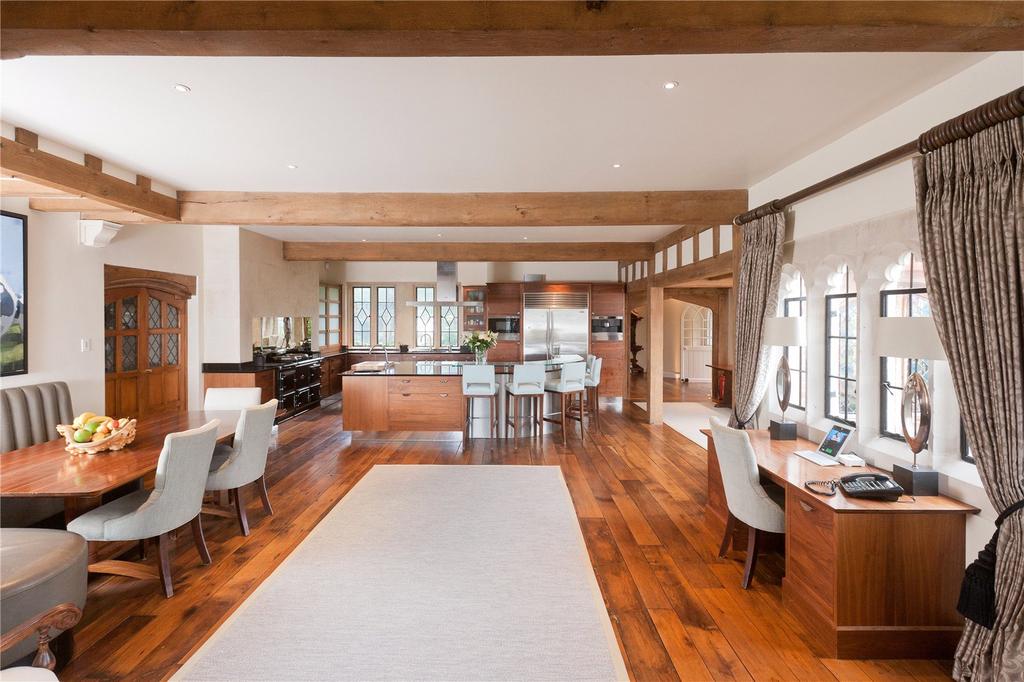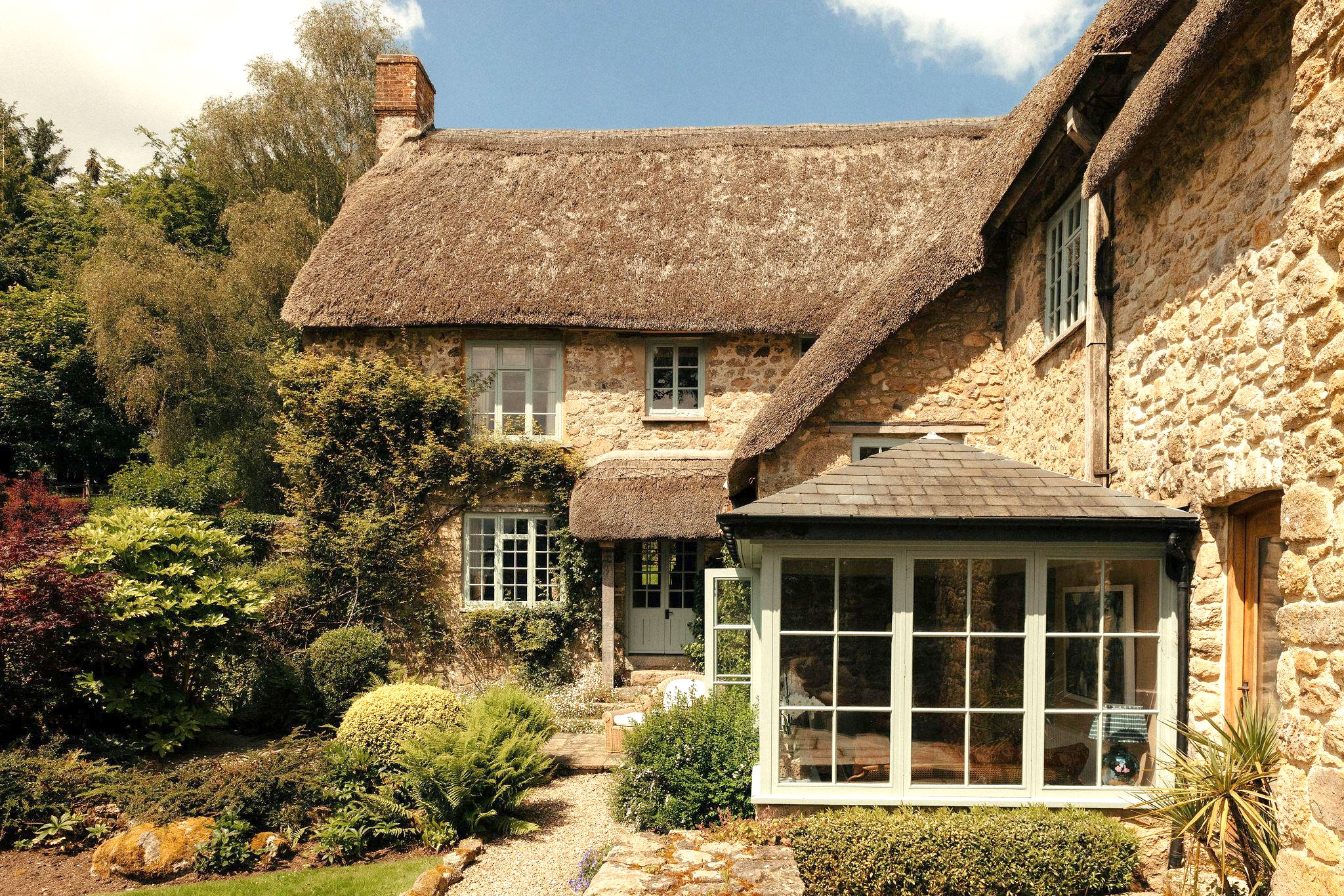An £18 million Surrey mansion, with vaulted hall, turrets, and a kitchen-diner the size of a three-bedroom house
Penny Churchill takes a look at the breathtakingly impressive Combe Court, in one of the prettiest locations in the Surrey Hills.


It’s always a pleasure to come across a genuinely historic country estate, the sort of place which has survived the upheavals of the 20th century to emerge resplendent in the 21st, thanks to sound long-term investment and upgrading by current owners.
Combe Court, in Surrey, is a perfect example — albeit one which has been pulled back from the brink, having at one point been converted into luxury apartments. You’d never know it to look at it today, however, and Crispin Holborow of Savills quotes a guide price of £18 million for this Grade II-listed, classic Victorian country house.

The place is set in 94½ acres of formal gardens, lakes, parkland and woodland in the heart of the Surrey Hills, two miles from the quintessentially English village of Chiddingfold, not far from Haslemere and Godalming.

The house stands on high ground overlooking its own grounds, with glorious southerly views over a wonderfully peaceful part of rural Surrey.

It’s a sprawling, beautiful building which offers more than 10,900sq ft of elegant, contemporary living space, including a grand vaulted reception hall.

The rest of the house takes in three main reception rooms, a study, a chapel (yes, really), utilities, cellars, and a kitchen/breakfast/family room which is vast. How cast? It's over 850 sq ft, roughly the same the floorspace of a modest three-bed semi.

There are principal and guest suites, with four en-suite bedrooms in the main house; but if you need more space, further accommodation is available in the detached coach house and two staff cottages.
Sign up for the Country Life Newsletter
Exquisite houses, the beauty of Nature, and how to get the most from your life, straight to your inbox.

The imposing main house and its stable block were both listed Grade II in 1983, following a reconstruction aftera 1970s fire, which saw the addition of a turret in the same Tudor Gothic style. In the late 1900s, it was owned by the music and film producer Tony Smith, best known for his association with the bands Genesis and Pink Floyd, who sold the estate to its present owners in 2008.

Improvements carried out under the present ownership include the renovation of the stables, the re-siting of the drive and the construction of the luxurious swimming-pool complex. Also in the pipeline is an application for planning and listed-building consent fora substantial three-storey extension.

Combe Court was built in 1850 by the Revd John Storer and acquired 10 years later by George Henry Pinckard, who ran the Clerical, Medical and General Life Assurance Company, founded by his uncle, from 1839–58 and remained a director of the company until his death in 1892. He died without a male heir, leaving the Combe estate to his nephew, John Coles, who changed his name to George Henry Pinckard in order to inherit.

During the First World War, the estate was let to the government on a 20-year lease, during which time it became a remount depot for the training of war horses and carriage mules.

At the start of the war, Britain’s equine army numbered 25,000 horses. However, many more would be needed and, in the first year of war alone, more than 460,000 horses held in private hands were compulsorily purchased by the army; many thousands more were imported from overseas.

At Combe Court, several of the horses and mules were trained by the owner’s daughters, the Misses Coral and Cherry Pinckard, before being shipped to the front, where an estimated eight million horses, mules and donkeys (from all sides) are said to have died during the four years of conflict.
Combe Court is for sale through Savills at £18m — see more details and pictures.
-
 What should 1.5 million new homes look like?
What should 1.5 million new homes look like?The King's recent visit to Nansledan with the Prime Minister gives us a clue as to Labour's plans, but what are the benefits of traditional architecture? And can they solve a housing crisis?
By Lucy Denton Published
-
 Having a ruff day: Kennel Club exhibition highlights the plight of vulnerable spaniel breeds
Having a ruff day: Kennel Club exhibition highlights the plight of vulnerable spaniel breedsPhotographer Melody Fisher has been travelling the UK taking photographs of ‘vulnerable’ spaniel breeds.
By Annunciata Elwes Published
-
 What should 1.5 million new homes look like?
What should 1.5 million new homes look like?The King's recent visit to Nansledan with the Prime Minister gives us a clue as to Labour's plans, but what are the benefits of traditional architecture? And can they solve a housing crisis?
By Lucy Denton Published
-
 Welcome to the modern party barn, where disco balls are 'non-negotiable'
Welcome to the modern party barn, where disco balls are 'non-negotiable'A party barn is the ultimate good-time utopia, devoid of the toil of a home gym or the practicalities of a home office. Modern efforts are a world away from the draughty, hay-bales-and-a-hi-fi set-up of yesteryear.
By Annabel Dixon Published
-
 Five beautiful homes, from a barn conversion to an island treasure, as seen in Country Life
Five beautiful homes, from a barn conversion to an island treasure, as seen in Country LifeOur pick of the best homes to come to the market via Country Life in recent days include a wonderful thatched home in Devon and a charming red-brick house with gardens that run down to the water's edge.
By Toby Keel Published
-
 The finest interiors in Edinburgh? A seven-bedroom townhouse furnished by Robert Kime comes to market
The finest interiors in Edinburgh? A seven-bedroom townhouse furnished by Robert Kime comes to marketSituated on one of the New Town's grandest terraces, this four-storey property is a collector's dream.
By James Fisher Published
-
 A Grade II*-listed country manor with one of the most beautiful drawing rooms in England
A Grade II*-listed country manor with one of the most beautiful drawing rooms in EnglandIf Old Manor Farm in Somerset is good enough for Pevsner, it's good enough for you.
By Penny Churchill Published
-
 An eight-bedroom home in Surrey where an army of robots will look after your lawns
An eight-bedroom home in Surrey where an army of robots will look after your lawnsDo not fear the bladed guardians of Monksfield House. They are here to help.
By James Fisher Published
-
 A French castle for sale on the banks of the Dordogne? With a swimming pool? Where do we sign?
A French castle for sale on the banks of the Dordogne? With a swimming pool? Where do we sign?This chateau in Lalinde is nothing short of a historical delight in the south of France. And it comes fully furnished.
By James Fisher Last updated
-
 Sip your morning tea where Churchill once paced, as his former Pimlico home comes up for sale
Sip your morning tea where Churchill once paced, as his former Pimlico home comes up for saleThe five-bedroom flat in Eccleston Square offers ‘historical gravitas and modern comfort’ in a leafy pocket of London.
By Annabel Dixon Published
